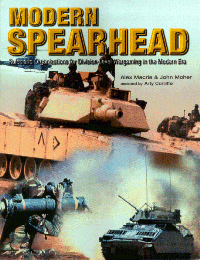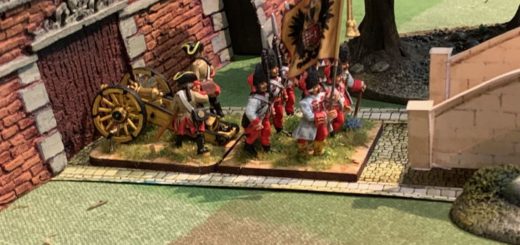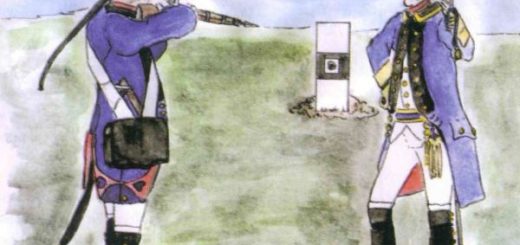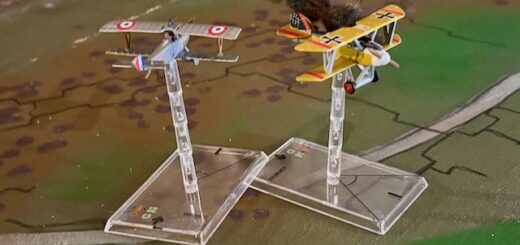Modern Spearhead

Modern rules designed mainly for 1/300 models. I believe that they are much more realistic respect to other rulesets, like Cold War Commander.
Official site: http://modernspearhead.net
Home rules
These rules have been written after reading an eye-opener book called “Arabs at War”, K.M. Pollack. I strongly recommend to everybody interested in understanding how armies behave in modern warfare.
Ground units disperse under air attack
Ground units not in cover tend to disperse when under air attack.
- Movement is compulsory for third world armies.
- Other armies throw 1D6:
- Veterans disperse on 1,2
- Regulars disperse on 1,2,3
- Green disperse on 1,2,3,4
Movement has to be done by all units under command (single battalion), each unit must move at highest speed away from air attack zone and towards cover. If cover does not exist unit will move away from air attack zone.Movement will continue until unit reaches cover or until battalion is rallied:
- Throw 1D6:
- Veteran battalion rallied on 3,4,5,6
- Regulars rallied on 4,5,6
- Green rallied on 5,6
Air attack does not necessarily need to cause casualties for battalions to disperse.(not used, it is superseded by Magegames Combat Chart).
Reconnaissance units targets
A Recce unit in recoinnassance mode cannot fire but gets targeted at -1 by all direct and indirect fires, as in cover. The firing unit is not obliged to fire on the recce and may disregard fire priority if other targets are available.
If a recce unit wishes to fire, it will loose this bonus and will be treated as a standard unit as a target.
This rule allows higher survivability of the recce units on the table, prompting them to observe and not fire, as it should be.
Irregular forces
Irregular forces do not behave as a centralised command army, but have to adhere to these rules.
- An irregular force may be given defence or attack orders at the beginning of the game.These orders are given by the higher command of the irregular force.
- Irregular forces may have small battalion sized units, so a command range of 6″ is added for “battalions” (combat groups) of six or less bases.
- Orders cannot be changed by higher command to a battalion when enemy units are sees, unless this battalion’s units see directly an enemy. This is effectively a self-change of orders, not prompted by a higher-level command. This self-change may be caused by seeing any enemy, so also recce units.This rule simulates the poor coordination of irregular forces.
- Irregular units are third world armies but do not follow any of their custom rules below, but just the standard MSH rules.
- Defence order. Irregular army defence order allow the irregular units to move within the “battalion” command range more freely and have a more flexible defence. It means that units may also disengage with backward movement (3″) and not only pivot in place by up to 45 degrees per move. Battalion HQ can move backward as well (3″), but only away from spotted enemy units.
- Irregular armies are not very resilient to enemy fire, so they:
- break-off combat (full two move retreat) on a bad morale roll every time one unit is destroyed in combat, unless they are at least with all units within a built-up area or on its edges, or all in cover or higher ground respect to any enemy firing unit.
- if a unit is destroyed by air units, the battalion does not flee in one direction but scatters in any direction at full speed (by the enemy player), away from spotted enemy ground troops. At the end of the two-move all irregulars must be within battalion command radius before any order can be issued. Better follow above rules on ground units dispersion…
- test morale also at 25% losses.
Third world armies
applies to Regular and Green Units, not Veterans. Examples are many units from Egypt 1948-1973, Iraq during all wars, Jordan in 1967.
Ground units disperse under air attack
(above rule not used, it has been superseded by Magegames Forced Order change rule, under air attacks).
Still, units under air attack or under threat of an air attack (Iraqis in 1991 Gulf War for example) are ambushed by all enemy units seen for the first time.
For example an Iraqi unit which is attacked by US troops in a sandstorm, gets fired before it actually sees the enemy and it is not able to answer beck in the same move, but it may fire in the next one.this effect simulates the unmanning or partial manning of vehicles and heavy weapons by troops expecting or under an air attack.
Compulsory Frontal Assault
The attack arrow of a third world army can only be straight, unless it goes along a road (see “Poor tactics on attacks along roads” below). Elaborate attacks cannot be carried out fior these armies, they just tend to go straight and do frontal attacks.If a more elaborate attack is chosen, it may be done in a series of straight arrows. Every time the battalion will go to defence and a new order will be necessary to make further attacks.
Poor combined arms assaults
This rule partly exists already, I just rephrase it and add a rule. Third world armies have difficulties in making combined arms attacks.Every unit in an attacking battalion must move at top speed. In this way becomes difficult to coordinate for example infantry attacks with attached tanks.
In addition to this, a non third-world enemy will be able to choose who to attack. Fire priorities, designed especially for developing combined arms attacks do not apply to third world targets.A combined arms-like attack is still possible, but it will not be very convenient as the case for better trained armies.
Poor tactics on attacks along roads
It is possible to make an attack arrow with bends (Compulsory frontal attack rule forces to attack using straight arrows), but only along roads. The command arrow is drawn on road, but all units must move along road.Some third world armies do not go outside roads, even when conducting an attack on enemy positions (example: Egyptians in Yemen in 1980’s).
Poor recce
Recce platoons of a third world army must remain within command distance of their parent battalion HQ, not up to 36″, as in standard rules.
Note
These rules for the player to make attacks on short distances, without complex manoeuvres and strategic scope. The player has the choice to make an attack in depth, for long distances, but it has to be along a road, in order of march (Egyptians did it in Yemen for example)The need to stop in defence, then throw new order dice for moving along a series of straight arrow causes delays anddisallows coordinated attacks.
Poor Ground attacks
Third world armies pilots are not very capable of attacking ground targets. Attacks are carried against ground troops with +1, respect to standard plane stats. They must be carried by only one flight per turn.(not used, it is superseded by Magegames Combat Chart).
Poor officers
When HQ of a battalion with defence order has any of his units assaulted, morale needs to be tested for the HQ in the Morale phase. On 1D6=1,2 the HQ flees.This rule simulates the effect of coward battalion commanders fleeing in front of an assault, like Jordanians officers in 1967, leaving their troops at their destiny in front of a direct israeli assault.The rout of the HQ will cause all defending troops to freeze in place, non being able to move or reorient to defend properly their positions.
Poor fire discipline
There are many accounts of third world units making heavy expenditure of ammunition (Syria in 1982 for example, Libyans in Tchad). In this case remove one ammo counter when ANY unit in a battalion fires.
- 2 ammo trucks removed per move, when 4+ platoons are firing, or when specialist ammunition is fired (support ATGW for example)
- 1 ammo truck is spent when 3 or less platoon fire, with no specialist ammunition fired.
- ammo trucks return in game as suggested in the logistic rule, but suffer from maintenance. Throw one die per truck spent, on fail it will not return as new supply and will be lost for the game.
Poor maintenance
Third world armies have a big problem with unit maintenance. Vehicles, even with simple failures are sent back to rear echelon instead of being repaired on the field. For this reason unit strengths are around 50-70% availability on average. At the beginning of the game throw one 1D10 per platoon, it appears on table with 50-70% chance.
Target has Poor tactical proficiency
Some third world armies are led by officers not adequately trained. Units are led in battle with very poor use of terrain to protect themselves, are rather immobile.
For this reason a +1 is given to all AT and AI attacks to units attacking enemies with poor tactical proficiency. (Examples are Syrians in 1973, Libyans in Chad in the ’80s).
Another example is Iraqis defending in poorly built sand berms. The -1 for cover in this case is negated by the +1 coming from this rule.
(not used, it is partially superseded by Magegames Combat Chart, in this case one would use Raw column as targets).
Poor weapon handling
Some third world armies are barely capable of using modern weapons, or at least they know how to use them at the basic level. For this reason a -1 is given when such units make AT or AI attacks. Examples are Libyans and Chadians in the ’80s).(not used, it is superseded by Magegames Combat Chart).
Poor Air-to-Ground attack training
Poor training of some air forces cause -1 on all ground attacks. Examples are Libyans in Chad.
Surrenders
Suppressed Green units from a Third World Army, failing a rally test and with enemy at 3″ or less, or in a neighbouring built-up area, will surrender to enemy units. Every surrendering base has to be guarder by an enemy base, which will not be able to move or fire for one move (it applies to iraqi in 1991 for example).
Strategic movement
These rules are meant to be used to connect between strategic movement on a mapo with march movement on the table.
Some rules must be devised, otherwise strategic movement of a Leopard II would be 6 km/hour, instead of the 20-25 km/hour in real life.
from Yahoo:
Assuming a time scale of 15 minutes (at the lower end of the permitted
window of 15 – 30 minutes for MSH) 4 turns is an hour. Which means
that:
6.0km an Hour for a leopard II
4.8km an Hour for a Leopard 1
3.6km an hour for a BRDM-2
2.4km for infantry
Another:
I found it interesting that the tankers recording their experiences in
the attack on Jalibah Airfield during Desert Storm reported combat
speeds of only 8mph (!) and 20mph. The .50cal on the Abrams is meant
to be fired when stationary! Many of the tankers stopped to fire
throughout the 24th’s campaign, stablization or no.
The Thunder Runs of 2003 were also conducted at well below 25mph.
During the Marine attacks on the river bridges the tanks almost
literally crawled.
Tanker friends of mine in the 80s spoke of hauling a$$ between covered
spots, but firing from the halt most often, and moving with infantry
components at their speed.
That contrasted considerably with the 73 Easting reports where the
infantry stayed mounted and all the vehicles moved together. Reports
vary, but some manuevring there was as slow as 12mph, at other times,
30!
Maybe combat is not as fast as I thought.
I need to look into strategic movement rates next, but it seems
operations are always conducted at speeds far below what vehicles are
capable of in theory.
Battalion with administrative vehicles movement, tanks are separated more, 1 vehicle every 4″‘ to take into account non-fighting vehicles?
If you’re going to try to represent road movement, then you must also
consider road space. For example a German WW2 tank battalion occupies
7200 yd (4 miles) of road and moves at 20 kph. [The speed is set by
doctrine and not vehicle performance, BTW.]
If we play on a map, and troops are declared on march, it becomes possible to move X4 respect to game movements. If attacked, such troops suffer a +2 attack modifier. Very risky!
This is map movement only, on table we use standard road movement. If a player decides to move in real march column, then he may decide to move X2 speed (one vehicle every 3 inches), with +1 modifier if attacked, or to move X4 (one vehicle every 4 inches), with a +2 modifier. Troops making such movement are seen at X1.5 and X2 distance.
Variable Lenght Turn
Throw dice at the end of every turn, time will pass by:
- 1 = time does not change significantly
- 2-5 = 15 minutes,
- 6 = 30 minutes.
The extracted time is used for timed orders, artillery barrages etcetera.



